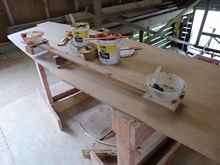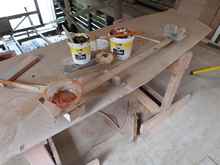Epoxy glues are quite sensitive to mix ratios, especially those that require proportions of 4 or 5 to one hardener to resin. These epoxies generally test as being a little stronger, and are preferred by most professional builders. But for the most part they come with pumps that dispense the right amount from each pump to make the right mix and you add your own powders to make up glue or fillers as required.
 |
There are four of "my" boats here, SCAMP closest, then a Cabin "Pathfinder", a Houdini with her red hull just visible, and a Navigator all built of sheet plywood and all epoxy glued and coated. All needed the mix to be correct, and all have been beautifully finished with no problems with glue or coating. The boats incidentally were on show at the 2013 Australian Wooden Boat Festival in Hobart, Tasmania, if you get a chance, go! |
Some epoxy fillers and glues though come as pre-mixed pastes rather than liquid resin, and there is no way that a plastic sauce pump will handle that stuff. Syringes, scales, devices for measuring volume in a cup, they all work but they are clumsy and take time so most people do their best to eyeball the quantities and hope that the volumes are close enough to get the right result. A mistake can be costly though, so some people go and borrow the kitchen scales. They then have to buy the cook a new set when its discovered that the stuff on the scales won't come off!(caught!).
Besides, that method needs arithmetic to work out how many grammes of hardener go with how many grammes of resin. Arithmetic was not my strong suit at school, being honest school was not my strong suit either but I get by.
I've been doing it the easy way.
I made a balance beam, I have one for each of the several different products that I use and have never had an issue with wrong proportions while using them.
 |
My balance beam for System 3 Ezy Fillet, 3/7 ratio. That balance beam would have taken all of 10 mins to make, including getting it to balance right, and I was not in any real rush. |
To explain, first read the labels on the product, they will tell you the correct ratio by weight. Not volume in this case, weight!
The product that I am using as an example is System 3 "Ezy Fillet" which is a highly reinforced filler used in stitch and tape construction, and although its 2/1 by volume its 3/7 by weight.
So I got a scrap of plywood, cut a little strip a little over 1000mm long and wide enough (I think its about 30mm wide but that does not matter much).
I measured 300mm in from one end, marking it and leaving 700 mm at the other. Add one to the other and we get 1000. (I might not have done well at arithmetic but I can do that much).
I got a piece of scrap 20mm about 60mm wide and 100 long, although the sizing is not at all important, it just needs to be of a width so that on edge it supports the balance beam with the counterweight clear of the bench and long enough to be stable when the assembly is sitting on it.
I planed a 90 deg vee on one edge, and nailed it to the balance beam with the edge of the vee downward and centered on the mark.
 |
Another view. I cut up a little more scrap ply to make a little platform on each end, marked a line across the middle of each and glued them into place (hot melt glue gun, handy thing). |
As assembled the long end will be very much heavier than the short end, so it needs a counterweight.
Before you start on that, decide on your mixing pots, you'll need to use the same ones each time, both ends, or the variation in weight will throw the mix ratio out. I use a little plastic pot of the type that supermarket delicatessens use for their ready made salads and such, the small one is about right and if you contact a "hotel and restaurant supply" outfit they'll sell you boxes of a thousand or so for peanuts. Otherwise tell the person who was growling about you "borrowing" the kitchen scales to keep you supplied with that size container via the grocery shopping. Yoghurt container, plastic cups from the bin beside your office water cooler, there are plenty to choose from.
With the appropriate container on each end, centered on the mark on the ply platform, cut a block of wood and put it on the short end, make it a bit big/heavy and gradually trim it until you are close to balancing. Do the final adjustment by putting a screw or a couple of nails in the end, when right, glue, screw or otherwise fasten the counterweight to the underside of the short end. Test again. Correct if needed.
To use, spoon resin into one end, and hardener into the other until it balances, scrape one into the other and mix. I use a separate stick, paddle or spoon at each end so there is no inadvertent contamination going on.
Replace the one you use with a similar one, and you are ready to go again. Large or small batches, no problem, Its always the right proportion.
|









